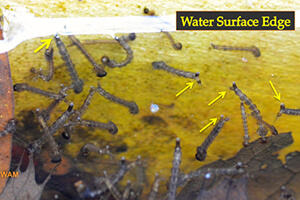
The heat of summer brings a dire necessity. The bees need water to cool their hives. Where will they get it and what is the bee biology behind water collection? Those are the subjects for this article.
Bees desperate for water will get it from unlikely places. For example, in 1878 during a hot dry summer, Mr. G. F. Merriam, a California beekeeper, reported that his bees even entered his house searching for water1. While that occurrence was extreme, bees searching for water can find it at typical places on neighboring properties where problems can occur. Bees collecting water at swimming pools cause consternation among swimmers and irate phone calls to beekeepers. Affordable above-ground pools can be found anywhere and trying to avoid them can be difficult when seeking apiary locations. And once a beekeeper establishes an apiary, someone could install a pool nearby and then complain about the bees. Birdbaths are also a typical place for bees to find water.
Once bees learn a water site, getting them to use another location, while the former one is still wet, is a very difficult long-standing problem in apiculture. The best work-around solution is for the beekeeper to provide water sites early in the season when bees need water for brood rearing (another desperate situation). The goal here is for the bees to stay away from water on neighboring property. Therefore, the beekeeper-provided sites should provide places for the bees to land safely without drowning, never go dry, and be near the hives.
With the Zika virus spread by mosquitoes, the damage to infant health, and the numerous Southern states covered in the potential disease spread map, I would emphasize water sites that do not allow the growth of mosquito larvae–no open stagnant water. (In mosquito reproduction, the larvae and pupae live in stagnant water. Both immature forms are mobile swimmers and need to rise to the water surface to breathe as shown in Figure 1. Mosquitoes in the genus Aedes spread the Zika virus, one being Aedes aegypti, a very familiar mosquito to those in the community studying tropical diseases. I have known about this mosquito for a long time having studied medical entomology. This mosquito is difficult to control.)
In the past, I think inadvertently in regards to stopping mosquito reproduction, beekeepers have devised such water sites, and bees readily accepted them. Typically they are some kind of water drip system that makes a seep, a damp place. The seep could be a wet cloth on an inclined board or a shallow pan of clean wet sand (see Figure 2). Without a large reservoir of standing water that sometimes is rain replenished, these dripping water-site designs have traditionally required more maintenance to keep them from drying out because the dripping reservoir can run out of water. In a Zika future, expect the importance of water sites, sans a mosquito larvae refuge, to demand better designs with lower maintenance.
Also when the beekeeper provides water for bees, it must be clean and free of pesticides. Contaminated water sources have been a recent concern. On the other hand, water with some kind of odor may help the bees learn to orient to it since bees are so sensitive to odors. Furthermore, understand that one colony can use more than one water source, one of which may be provided by the beekeeper. The others may be beyond the beekeeper’s control.
Now let’s turn to a detailed look at how bees collect a…
PHOTO CAPTION
Mosquito larvae. The larger larvae are easy to see. The yellow arrows show where the larvae have pierced the water surface to breathe. With the spread of the Zika virus, expect more emphasis on water sites provided by beekeepers not having standing water for mosquito reproduction.


